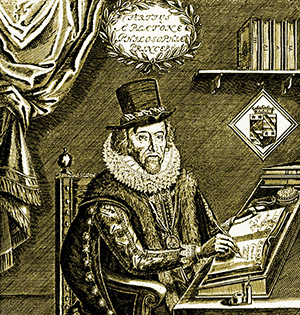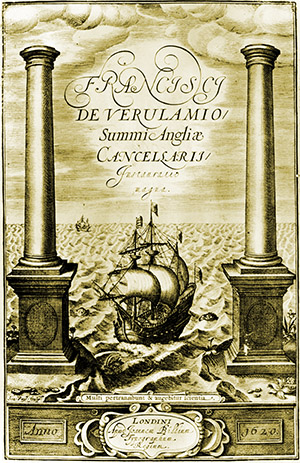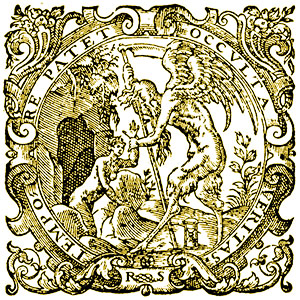Hermes
“Next unto God, Love is the Cause of Causes, itself without any Cause.”
Francis Bacon: Cupid and Coelum, On Principles and Origins
Hermes - Plato - Solomon
As a philosopher, Francis Bacon was likened to three famous "ancient" philosophers, Hermes, Plato and Solomon. He also referred to himself as the “herald of a new time”—a time of paradise on earth, ushered in by the “last ages” when “the thorough passage of the world and the advancement of the sciences are destined by fate, that is, by Divine Providence, to meet in the same age”. 1 In this statement Bacon seems to deliberately associate himself with Elias the Artist whom Paracelsus prophesied would appear to the world at the time of the celestial events of 1602-4 and usher in an era of enlightenment. These associations act as gateways to a better understanding of Bacon and his philosophy.
At one time Bacon intended to publish his philosophical work with himself disguised as author under the pseudonym of Valerius Terminus and as editor or annotator under the pseudonym of Hermes Stella. This he never did, deciding to use his own name instead; but by the time he came to publish his final work he was being likened or likened himself to Plato, as portrayed in the frontispiece to the 1640 edition of his Of the Proficience and Advancement of Learning where he is named “the Third Plato”. He also, in his New Atlantis, associated himself with Solomon, as a ‘Second Solomon’ called Solamona. King James I referred to him in letters as both Solomon and Apollo. These comparisons parallel the ones with Orpheus and St Alban. All of these “ancients” were renovators and innovators, purifying, reinterpreting and reinvigorating the society and stream of consciousness with which they were involved and raising it to a new and higher level.
Valerius Terminus
Valerius Terminus is an invented double name having reference to the celebrated Roman, Publius Valerius, and the Roman god, Terminus.
Publius Valerius, together with Junius Brutus, were renowned for expelling the Tarquins after the rape of Lucrece and founding the Roman commonwealth. As a result, Valerius was nicknamed Publicola, meaning 'friend of the people'. He raised an everlasting monument to the Gemini, as is recorded on an inscription in the Temple of Castor and Pollux in ancient Rome.
Terminus is the Roman god of boundaries, represented with a human head and without arms or feet. He is equated with Janus, the Doorkeeper, who stands on the boundary between earth and heaven, finite and infinite, mortality and immortality, and past and future. Janus is another name for Saturnus (Saturn), known as Pan or Time, who sets boundaries on our lives and thereby enables the process of evolution and initiation to take place. For this reason he is traditionally known as the Hierophant and Initiator (i.e. Teacher and Tester). Bacon refers to him as the one who brings forth the truth and as representing the faculty of imagination.
The double name, Valerius Terminus, thus embodies the idea of the mortal-immortal, or man-god, the same theme as that of the Gemini and the major theme which underlies the Shakespeare mystery.
Hermes Stella
Hermes Stella refers to the great sage Hermes Trismegistus, a Greek name for the Egyptian god-man Thoth, who was called Mercurius by the Romans. The Star (Latin, Stella) of Hermes refers astronomically to the planet Mercury, known as the Morning Star, herald of the Sun, and is symbolic of Mercury, the god of eloquence and reason.
The title Trismegistus, meaning ‘Thrice Great’, refers to Hermes’ knowledge of the three parts of the wisdom of the whole universe. Francis Bacon, like Marsilio Ficino before him, states that this refers to Hermes having the power and fortune of a king, the knowledge and illumination of a priest, and the learning and universality of a philosopher. 2
The Hermetic teachings are of two types: one where Hermes is the pupil of Pymander, the Divine Mind (Nous) that is the “Shepherd of Men”, and the other where Hermes is the godlike teacher who instructs his pupil Asclepius. In either case, the teacher is the ‘immortal’, and the pupil the ‘mortal’.
The famous teaching associated with Hermes concerns the mystical marriage of heaven and earth, thereby producing the immortal-mortal. Bacon translated this Hermetic wisdom, for the purposes of his magnum opus (‘The Great Instauration’), into the ‘Egyptian’ symbolism of the Pyramid of Divinity and Pyramid of Philosophy, and the associated symbolism of the Great Pillars, known also as the Pillars of Atlas, Pillars of Enoch, Pillars of Hercules or Pillars of Solomon. The Pyramid of Divinity concerns the immortal Wisdom, whilst the Pyramid of Philosophy concerns the mortal mind or intelligence that is trying to understand and know that Wisdom.
Bacon further described these two Pyramids as the Mistress (Divinity) and Handmaiden (Philosophy), wherein the handmaiden is servant to the mistress in a mutually loving and harmonious relationship. In using these terms, Bacon is referring to divine Wisdom as Sophia, whilst Philosophy means 'the love of Sophia' (i.e. the love of Wisdom). The philosopher is the lover of Wisdom—the lover of Sophia.
Bacon’s family motto was “Mediocria firma”, which refers to the Middle Path that leads between the two Pillars (or Pyramids), balancing and uniting them in harmony and love—in other words, the Mystical Marriage.
The Third Plato
The name Plato, a word seemingly derived from Greek ap-Lato, ‘son of Lato’ (i.e. Apollo), was first used by the 4th century BC Greek poet-philosopher Aristocles, son of Ariston, who took the name as his pseudonym. He, the ‘First Plato’, was the famous pupil of Socrates and, like Socrates, an initiate of the Pythagorean and Orphic tradition, which was Hermetic in origin. Plato founded the first Academy in 387 BC, in the Grove of Academus. The main philosophical thrust of the European Renaissance was derived primarily from Plato via Ficino.
The ‘Second Plato’ was the 15th century Italian scholar Marsilio Ficino, who was commissioned by Cosimo de’ Medici to translate into Latin the Hermetic writings and the dialogues of Plato, together with the Neoplatonic writings of Porphyry, Proclus, Pseudo-Dionysus the Areopagite and Plotinus. Ficino’s understanding was that a divine theology or wisdom tradition, based on love, began simultaneously with Zoroaster among the Persians and with Hermes Trismegistus among the Egyptians, and that this wisdom tradition led in an unbroken chain to Plato via Orpheus and Pythagoras. Moreover, it is this wisdom which underlies the Hebrew, Orphic and Christian teachings.
Ficino regarded both philosophy and religion as being manifestations of a spiritual life, each needing the other in order to attain the summum bonum or greatest good. According to the Neoplatonic philosophy which he founded, love is the sustaining principle of the universe, and the attainment of the highest good is dependant not upon the Church but upon an impulse universal to mankind. The soul is not only immortal, but all souls by an inner urge naturally seek truth and goodness.
Francis Bacon was the next in line of these great philosophers—the 'Third Plato'—who likewise laid the foundations for the next great leap in human consciousness. The name Plato is a synonym of Apollo, and Bacon was referred to many times as Apollo, including by King James: "I saye with Apollo 'media tutius itur' ('the middle way is safer') if it may stande with lawe" 3.
Solomon
King Solomon (Hebrew Shalomoh, ‘the Peaceful One’) was renowned for his wisdom, for building the temple at Jerusalem, and for his poetry and writings—notably, his Book of Wisdom, his Song of Songs, his Proverbs and his Natural History. According to rabbinic tradition he was one of the great masters of Kabbalah, and according to Freemasonic legend he formed a Masonic fraternity to design and construct the temple.
Not only was Bacon fond of the wisdom of Solomon, likening himself to the king who searches out the truth after God has hidden it (1 Proverbs xxv, 2), but also he sought to be like Solomon in terms of writing books of wisdom, poetry, philosophical axioms and natural history, and forming a fraternity in learning and illumination to build a temple of light—a temple of knowledge and illumination in the human mind.
In his New Atlantis, Bacon personifies himself as Solamona, the founder of Salomon’s (Solomon’s) House—an “Order or Society…dedicated to the study of the works and creatures of God" 4.
Trismegistus
Interestingly, the three main enlightened human beings to whom Bacon is likened form, in their grouping, a 'Trismegistus' description—a king (Solomon), a philosopher (Plato) and a priest (Hermes).



